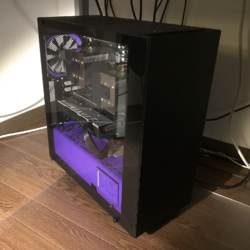Umaru
umaru is my "daily driver" desktop computer, the default choice for most tasks.
Etymology
"umaru" (埋まる) in Japanese means for something that was empty to become full, or for a deficiency or vacancy to be remedied. At the time it was first built, I had two reasonably modern desktop machines that were struggling, and I needed something else to take the lead role. Being a generic PC build, I was conscious of the possibility that once finished, I could refresh the components at will, resolving the present problem for the foreseeable future.
Umaru is also the titular character of comedy anime about a girl who maintains multiple personalities in separate social contexts, which was current in Japanese pop culture at the time. I saw a parallel because this machine's identity was indeterminate and shifted relatively often during the first several years of its existence.
History
By the summer of 2015, Solaris was gradually becoming more difficult to run as a desktop platform. The most troubling issue was Firefox only being available in binary form as a 32-bit release, which crashed and dumped core when it ran out of addressable memory space. As websites got progressively more ambitious, these occurrences became increasingly frequent. inari was aging, too, and instead of uprooting its Solaris environment (it was also a de facto file server at the time), I moved towards building a new machine and making a DIY PC the center of my environment for the first time.
I was also turning my attention back toward Mac OS X, reasoning that if Solaris became untenable as a desktop platform, I may as well return to one I could more or less rely on, that I had long experience with on the desktop. My X11 desktop at the time was just a lightly customized GNOME 2/Compiz environment, faster-moving generic Unix was in the midst of upheaval caused by GNOME 3, and trying to jump into that seemed counterproductive. The spatial file manager and a handful of especially good utilities like Sonata (the mpd client) were the only major advantages of my Solaris environment relative to Mac OS X.
uzume was still nominally in active use and not particularly old, so I upgraded it from Mac OS X 10.8 to 10.10 to get a feel for the current state of Mac OS X. Deciding it was about as good as ganymede save for the regrettable obsolescence of OmniWeb, I shifted more responsibilities in its direction, but soon found that the Sandy Bridge mobile CPU could not keep up with my usage habits. The machine more or less kept up, but with its fans howling and with a periodic stutter. If I were to return to Mac OS X, I would need a new machine, ideally in an airy desktop case and with a desktop CPU.
First Build, Mac OS X: December 2015 - September 2017
After some deliberation, I decided to try the "Hackintosh" route of running Mac OS X on non-Apple x86 hardware, which looked easier by 2015 than it had been in the early days of Intel Macs. I wasn't sure what to expect, though, so I started with the possibility of switching to generic Unix later in mind. Choosing to start with Mac OS X had a major impact on hardware selection, where I used an overspec ASUS Z97-WS motherboard in hopes of better compatibility, and an Intel 730 SATA SSD, because NVMe did not work on non-Apple hardware.
FreeBSD: September 2017 - September 2018
Arch Linux: September 2018 - September 2019
Talos II Rebuild, Debian 10: September 2019 - September 2021
Fedora: September 2021 - January 2022
Gentoo: January 2022 - Present
Slot Configuration
- SLOT 1 Intel Optane 900P 280GB NVMe SSD
- SLOT 2 Sapphire Pulse AMD Radeon RX580 GPU
- SLOT 3 Empty (covered by GPU in SLOT 2)
- SLOT 4 LSI SAS2308 SAS2 HBA
- SLOT 5 Owltech OWL-PCEXU3E4 USB 3.0 (NEC μPD720201 Controller)
History
- 2019-10-08 Replace Hynix DIMMs with Micron DIMMs.
- 2019-09 Issues with Hynix DIMMs limit usable memory to 56GB.
- 2019-09-08 Install Debian 10 ppc64le.
- 2019-09-07 Rebuild based on Talos II.
- 2018-09 Change OS to Arch Linux.
- 2018-08 Switch primary mass storage to Intel 900P.
- 2018-01 Case swap to NZXT S340 Purple Edition.
- 2017-09 Change OS to FreeBSD. Swap original Intel 730 SSD for spare m.2 NVMe SSD.
- 2015-12 First build with ASUS Z97-WS and white NZXT H440, running Mac OS X 10.11.
External Links
| inari 2011-2015 |
Maia's primary desktop 2015- |
Current |
